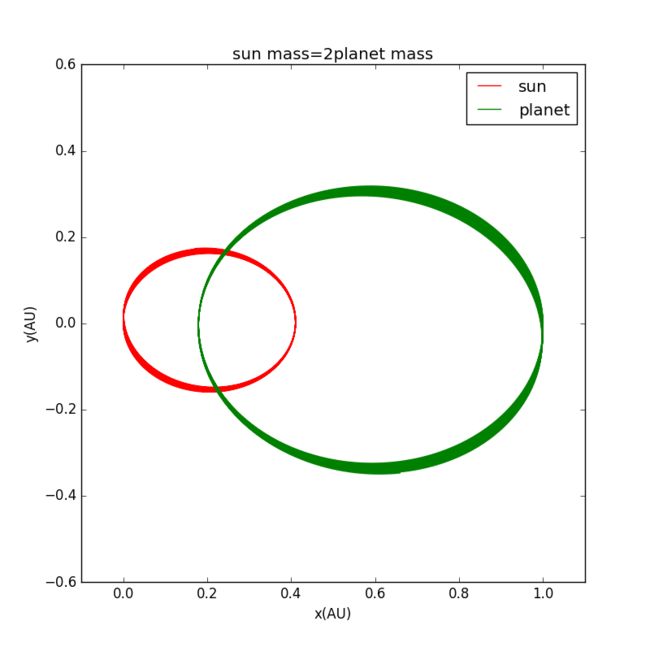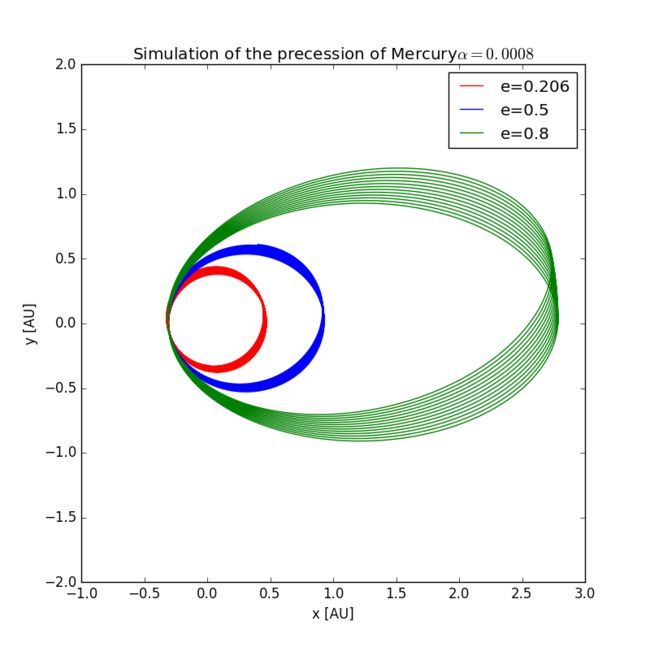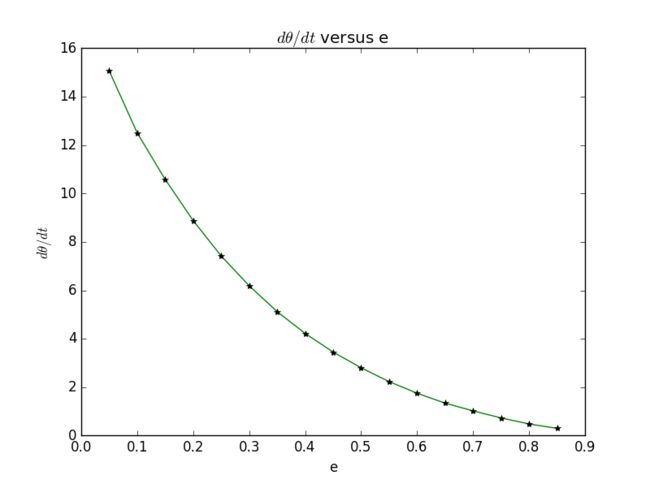1. Abstract
We born in here, we live in here, here is our solar system. If we don't care about it, who will care about it? If we don't care about it, then both us and our descendants will die alone on this dead planet.
Now, we will consider several problems that arise in the study of planetary motion. After that, maybe you will feel better.
Question 4.8
Verify Kepler's third law for elliptical orbits. Run the planetary motion program with initial conditions chosen to give orbits that are noncircular. Calculate T2 / a3 and compare with the values given in Table 4.2.
Question 4.11
Investigate how the precession of the perihelion of a planet's orbit due to general relativity varies as a function of the eccentricity of the orbit. Study the precession of different elliptical orbits with different eccentricities, but with the same value of the perihelion. Let the perihelion have the same value as for Mercury, so that you can compare it with the results shown in this section.
2. Background and Introduction
According to Newton's law of gravitation the magnitude of this force is given by
From Newton's second law of motion, we have
At coordinates (x,y), we have
We now follow our usual approach and write each of the second-order differential equations in (2) as two first-order differential equations
In our solar system, It must have
We next convert the equations of motion (4) into difference equations in preparation for constructing a computational solution. We have
For our solar system case, the solution can be expressed as
where a is given by
For the perihelion and the aphelion
The force law predicted by general relativity is
Some useful planetary date are given by sheet1
| planet | mass(kg) | radius(AU) | eccentricity |
|---|---|---|---|
| Mercury | 2.4 \times10**23 | 0.39 | 0.306 |
| Venus | 4.9 \times 10**24 | 0.72 | 0.007 |
| Earth | 6.0 \times 10**24 | 1.00 | 0.017 |
| Mars | 6.6 \times 10**23 | 1.52 | 0.093 |
| Jupiter | 1.9 \times 10**27 | 5.20 | 0.048 |
| Saturn | 5.7 \times 10**26 | 9.54 | 0.056 |
| Uranus | 8.8 \times 10**25 | 19.19 | 0.046 |
| Neptune | 1.03 \times 10**26 | 30.06 | 0.010 |
| Pluto | ~6.0 \times 10**24 | 39.53 | 0.248 |
3. Body Content and Conclusion
(1) Earth orbirts for different initial velocity
First, we consider a simple situation, when the earth sets out at r=1AU with initial velocity 2\pi(AU/yr), 1.5\pi(AU/yr) or 2.5\pi(AU/yr), its orbits are shown in the following figure.
Click the Code
-
Conclusion: when the move with velocity 2\pi (AU/yr), its orbit is a circular. However, when its velocity is larger or smaller, its trajectory will be ellipse.
(2) The two-body problem
Although it's hard to notice this phenomennon in our solar system, but it is really exsit. For example, if we assume that the mass of the earth is half of the sun, something will be happen.
Click the Code
-
Conclusion: from the figure above, although their orbits are very regular, but it is not a simple circular or a ellipse.
(3) The three-body problem
It is unnecessary for us to talk about our main task before we know something about the three-body problem.
Click the Code
-
Conclusion: from picture, we find that a three-body system just like a chaotics system. their trajectory are unpredictable.
(4) Question 4.8-Verify Kepler's third law for elliptical
IN order to solve this problem, I chose the Venus, the Earth, the Mars, the Jupiter and the Saturn as examples. According to sheet1, we can plot their orbits and verify Kepler's third law. The sheet2 is given below.
| planet | k(yr2/AU3) |
|---|---|
| Venus | 0.997 |
| Earth | 0.998 |
| Mars | 1.005 |
| Jupiter | 1.010 |
| Saturn | 0.988 |
Click the Code
The following is my result.
| planet | k(yr2/AU3) | error |
|---|---|---|
| Venus | 0.9999 | 0.29% |
| Earth | 1.0000 | 0.20% |
| Mars | 0.9999 | 0.51% |
| Jupiter | 1.0264 | 1.62% |
| Saturn | 1.0077 | 1.99% |
-
Conclusion: even though there exsit some errors, we can also regard k= T2/a^3 as a constant 1 (yr2/AU3). Thus, we verified Kepler's third law for elliptical orbits.
Of course, we can also examine our results with theoretical fuction.
Click the Code
-
Conclusion: my result matched the theoretical very well.
(5) Question 4.11-Precession of the perihelion of Mercury
As a matter of fact, the precession of Mercury is not noticeable. So, we choose \alpha=0.01.
Click the Code
-
Conclusion: it is obvious that there exsits precession.
Then, we can plot precession of the axis of Mercury's orbit as a function of time. Here, we choose \alpha=0.0008.
Click the Code
Now, it's time to consider how the precession of the perihelion of a planet's orbit due to general relativity varies as a function of the eccentricity of the orbit. We choose e=0.206, 0.5, 0.8.
Click the Code
-
Conclusion: when the eccentricity of the orbit is larger, the orbit will be larger. However, it is hard to talk about their precession.
So, we consider this question in another method.
-
Conclusion: from this figure, we will find that when e is larger, its precession will be smaller.
A more detail figure is given below.
-
Conclusion: surprisingly, precession rate attenuates exponentially with eccentricities.
4. Reference and Acknowledgement
-
Thanks to upperclassmen- Chen Feng (vpython figure from him) and Wang Shixing
-
Computational Physics (Second Edition), Nicholas J. Giordano, Hisao Nakanishi.


















